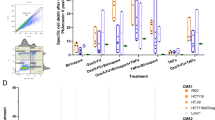Abstract
PURPOSE: The effect of N-methylformamide, used in combination with the antineoplastic drugs adriamycin and cisplatin, on the cell survival of a colon carcinoma cell line (HT-29) was investigated. To better understand the mechanism involved in N-methylformamide-mediated chemosensitization, we evaluated the N-methylformamide effect on cell volume and surface expression of some integrins molecules (VLA2, VLA5, and VLA6) of the HT-29 cell line. METHODS: The cell survival was evaluated by clonogenic assay; integrins surface expression was analyzed by means of flow cytometry; cell volumes were determined using a Coulter Channalyzer. RESULTS: A Noncytotoxic dose of N-methylformamide (170 mM) sensitizes the HT-29 cell line to the lethal activity of both adriamycin and cisplatin. The analysis of cell volume showed that N-methylformamide exposure induces an increase in cell volume. Flow cytometric analysis of VLA2, VLA5, and VLA6 receptors showed that N-methylformamide increases the expression of the three integrins by 30 to 40 percent. CONCLUSION: The plasma membrane could constitute one of the N-methylformamide targets and might be involved in the differentiation and chemosensitizing effects caused by this agent. Moreover,N-methylformamide could improve colon cancer treatment when used in combination with antineoplastic drugs.
Similar content being viewed by others
References
Pierce GB, Speers WC. Tumors as caricatures of the process of tissue renewal: prospects for therapy by directing differentiation. Cancer Res 1988;48:1996–2004.
Sartorelli AC. Malignant cell differentiation as a potential therapeutic approach. Br J Cancer 1985;52:293–302.
Marks PA, ed. Genetics, cell differentiation and cancer, Bristol-Myers cancer symposium. New York: Academic Press, 1985:209–15.
Marks PA, Sheffery M, Rifkind RA. Induction of transformed cells to terminal differentiation and the modulation of gene expression. Cancer Res 1987;47:659–66.
Feron ER, Vogelstein B. A genetic model for colorectal tumorigenesis. Cell 1990;61:759–67.
Ramsay RG, Thompson MA, Hayman JA, Reid G, Gonda TJ, Whitehead RH. Myb expression is higher in malignant human colonic carcinoma and premalignant adenomatous polips than in normal mucosa. Cell Growth Differ 1992;3:723–30.
Reuben L, Garth LN. Can anticancer therapy be improved by sequential use of cytotoxic and cytostatic (differentiating or immunomodulating) agents to suppress tumor cell phenotypic diversification? Biochem Pharmacol 1988;37:2149–54.
Bigley CG, Metcalf D, Nicola NA. Purified colony stimulating factors (G-CSF and GM-CSF) induce differentiation in human HL60 leukemic cells with suppression of clonogenicity. Int J Cancer 1987;39:99–104.
Trinchieri G, Perussia B. Immune interferon: a pleiotropic lymphokine with multiple effects. Immun Today 1985;6:131–8.
Trinchieri G, Kobayashi M, Rosen M, Loudon R, Murphy M, Perussia B. Tumor necrosis factor and lymphotoxin induce differentiation of human myeloid cell lines in synergy with immune interferon. J Exp Med 1986;164:1206–11.
Reiss M, Gamba-Vitalo C, Sartorelli AC. Induction of tumor cell differentiation as a therapeutic approch: preclinical models for hematopoietic and solid neoplasms. Cancer Treat Rep 1986;70:201–18.
Spremulli EN, Dexter DL. Polar solvent-a novel class of antineoplastic agents. J Clin Oncol 1984;2:227–41.
Tofilon PJ, Vines CM, Milas L.N-methylformamide-mediated enhancement of in vitro tumor cell chemosensitivity. Cancer Chemother Pharmacol 1986;17:269–73.
Dibner MD, Irelaand KA, Koerner LA, Dexter DL. Polar solvent-induced changes in lipid lateral diffusion in human colon cancer cells. Cancer Res 1985;45:4998–5003.
Tapiero H, Fourcade A, Billard C. Membrane dynamics of friend leukaemic cells. Changes associated with cell differentiation. Cell Differ 1980;9:211–8.
Smolle J. Biological basis of metastasis formation. Hautarzt 1992;43:55–64.
Juliano R. Membrane receptors for extracellular matrix macromolecules: relationship to cell adhesion and tumor metastatis. Biochim Biophys Acta 1987;907:261–78.
Steven MA, Stephen AM, David EE, RoseMary S, Laszlo D, Meenhard H, Clayton AB. Integrins distribution in malignant melanoma: association of theβ 3 subunit with tumor progression. Cancer Res 1990;50:6664–757.
Virtanen I, Korhonen M, Kariniemi AL, Gould VE, Laitinen L, Ylanne J. Integrins in human cells and tumors. Cell Differ Dev 1990;32:215–27.
Drewinko B, Loo TL, Brown B, Gottlieb JA, Freireich EJ. Combination chemotherapy in vitro with adriamycin. Observation of additive, antagonistic, and synergistic effects when used in two-drug combinations on cultured human lymphoma cells. Cancer Biochem Biophys 1976;1:187–95.
Del Bufalo D, Zupi G, D'Agnano I, Falcioni R, Marangolo M, Sacchi A. Growth inhibition of HT-29 cells exposed to N-methylformamide correlates with altered expression ofα6/β4 integrin. Int J Oncol 1992;1:97–105.
D'Agnano I, Turchi V, Nuti M, Leonetti C.N-methylformamide effects on cell proliferation and antigenic pattern in HT-29 colon carcinoma cell line. Cell Prolif 1992;25:299–309.
Greco C, Del Bufalo D, Giannarelli D, Marangolo M, Fuggetta MP, Bonmassar E, Zupi G.N-methylformamide affects spontaneous metastases of 3LL lines and increases natural killer activity of tumor-bearing mice. Clin Exp Metastatis 1990;8:153–63.
Zupi G, Marangolo M, Arancia G,et al. Modulation of the cytotoxic effect of 5-fluorouracil byN-methylformamide on a human colon carcinoma cell line. Cancer Res 1988;48:6193–200.
Laudonio N, Zupi G, Erba E, Leonetti C, D'Incalci M. Synergism between 5-fluorouracil andN-methylformamide in HT-29 human colon cancer line. Br J Cancer 1990;61:377–81.
Arancia G, Leonetti C, Malorni W,et al. Different effects of sequential combinations ofN-methylformamide with 5-fluorouracil on human colon carcinoma cells growing in nude mice. J Cancer Res Clin Oncol 1991;117:351–8.
Charcosset JY. Effects of antineoplastic agents on the cell cycle progression. Biol Cell 1986;58:135–8.
Cordeiro RF, Savarese TM. Role of glutathione depletion in the mechanism of action ofN-methylformamide and N,N-dimethylformamide in a cultured human colon carcinoma cell line. Cancer Res 1986;46:1297–1302.
Colin AB, Gescher A, Hickam AJ. Effects ofN-methylformamide on the growth, cell cycle, and glutathione status of murine TLX5 lymphoma cells. Cancer Res 1988;48:3389–93.
Seftor RE, Seftor EA, Gehlsen KR,et al. Role of theα v β 3 integrin in human melanoma cell invasion. Proc Natl Acad Sci USA 1992;89:1557–61.
Author information
Authors and Affiliations
Additional information
This work was supported by grants from Ministero delia Sanità and by CNR-ACRO Grant 9202370PF39.
About this article
Cite this article
Del Bufalo, D., Bucci, B., D'Agnano, I. et al. N-methylformamide as a potential therapeutic approach in colon cancer. Dis Colon Rectum 37 (Suppl 2), S133–S137 (1994). https://doi.org/10.1007/BF02048446
Issue Date:
DOI: https://doi.org/10.1007/BF02048446




